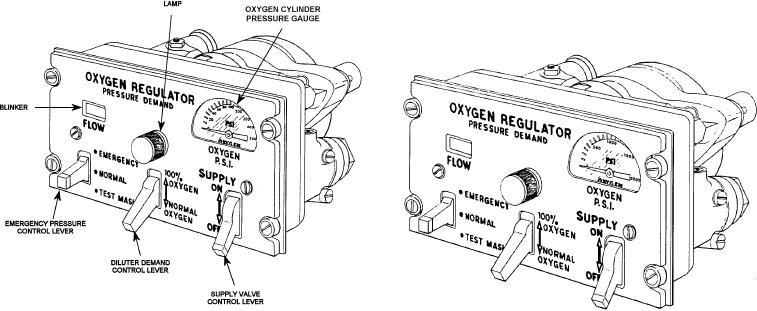
with the tube in the outlet port of the unit, so that only
pressure balanced except for the light imbalance caused
the pressure sent to it by the exhalation valve pickup
by an area advantage on the backside of the diaphragm,
tube compensates the exhalation valve.
which provides a positive sealing force.
The vacuum caused by inhalation causes the
AIRCRAFT-MOUNTED OXYGEN REGULA-
sensing diaphragm to tilt downward, pushing down the
TORS.--The MD series regulator is being used in
demand-actuating paddle. As the paddle is forced
several multi-place naval aircraft. There are two types
downward, its base is lifted from a seat, which seals a
of regulators in this series--the MD-1 (low-pressure)
second passageway from the backside of the demand
(fig. 7-14) and the MD-2 (high-pressure) (fig. 7-15).
valve diaphragm. Raising the paddle base allows flow
The only difference found in these regulators is operat-
from this area, which causes a pressure drop behind the
ing pressure. The operating pressure of the MD-1 regula-
demand valve diaphragm and allows inlet pressure to
tor is 50 to 500 psi. The pressure gauge reads 0 to 500
lift the diaphragm from its seat, and oxygen flow occurs.
psi. The operating pressure of the MD-2 regulator is 50
to 2,000 psi. The pressure gauge reads 0 to 2,000 psi.
Safety pressure is obtained by the safety pressure
spring, which deflects the sensing diaphragm, causing
The following controls and indicators are located
flow through the unit until the force created by mask
on the front panel of the regulator. The small
pressure equals the force of the spring. This returns the
oblong-shaped window area on the left side of the panel
sensing diaphragm to a balanced condition.
marked FLOW indicates the flow of oxygen through
the regulator by a visible blinking action. The pressure
Automatic pressure breathing is obtained by
gauge is on the upper right and indicates inlet pressure
diverting a small volume bleed from the inlet passage to
to the regulator. The regulator has three control levers.
the aneroid chamber. This bleed is normally vented
A supply valve controller lever, on the lower right
from the aneroid cavity past the area labeled aneroid
corner, is used to control the supply of oxygen to the
vent. At the altitude at which pressure breathing is to
regulator; a diluter control lever, on the lower center of
begin, the lip of the aneroid comes in contact with the
the panel, has two positions--100% OXYGEN and
seat, closing off the aneroid vent and building up
NORMAL OXYGEN; an emergency pressure control
pressure, which reacts on the sensing diaphragm. The
lever, on the lower left of the panel, has three
pressure lifts the sensing diaphragm, causing flow until
positions--EMERGENCY, NORMAL, and TEST
the mask pressure exerts a force on the sensing
MASK, and with the diluter lever in the 100%
diaphragm equal to the force exerted by pressure
OXYGEN position, the regulator delivers 100 percent
buildup in the aneroid chamber.
oxygen upon inhalation by the user. In the NORMAL
The relief valve on the unit acts as a pilot device to
OXYGEN position, the regulator delivers a mixture of
open the exhalation valve of the mask. This is done by
air and oxygen with the air content decreasing until a
isolating the pressure pickup of the exhalation valve
cabin altitude of approximately 30,000 feet is reached.
Above this altitude, 100 percent oxygen is delivered to
the user upon inhalation.
Figure 7-14.--Aircraft panel mounted oxygen regulator, type
Figure 7-15.--Aircraft panel mounted oxygen regulator, type
MD-1.
MD-2.
7-15

